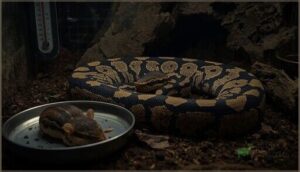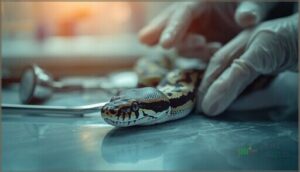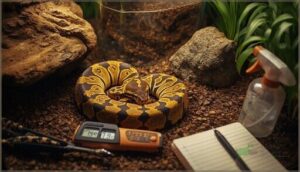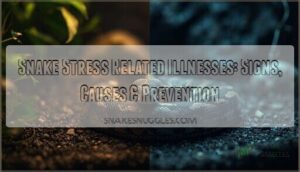This site is supported by our readers. We may earn a commission, at no cost to you, if you purchase through links.
Your ball python refuses her next meal, then another. By week three, she’s spending more time in her water bowl than usual, and you notice a slight wheeze when she breathes. These subtle shifts might seem minor, but in reptiles, they’re often the body’s distress signals broadcasting loud and clear.
Unlike mammals that telegraph illness through obvious cues, snakes mask their vulnerabilities until problems become serious—a survival instinct that works against them in captivity. Understanding when your snake needs professional vet care, what that care involves, and how to prevent common health crises can mean the difference between a straightforward treatment and a life-threatening emergency.
Recognizing the early warning signs and knowing how to respond gives you the power to intervene before minor issues spiral into major complications.
Table Of Contents
Key Takeaways
- Snakes mask illness until problems become serious, so you need to watch for subtle warning signs like appetite loss, breathing changes, or abnormal shedding before they escalate into life-threatening emergencies.
- Respiratory infections, parasitic infestations, and skin conditions stem primarily from environmental factors—maintaining proper temperature (75-85°F), humidity (40-60%), and enclosure hygiene prevents most common health crises.
- Early veterinary diagnosis improves survival rates by 87% and cuts recovery time in half, making annual checkups and immediate attention to urgent signs like breathing distress or severe trauma essential for your snake’s longevity.
- Finding qualified reptile veterinarians can be challenging since only 2.1% of US vets hold reptile certifications, but establishing this relationship before emergencies arise creates a safety net that catches fixable problems early.
Common Health Problems in Pet Snakes
Pet snakes face several health challenges that stem from both environmental factors and husbandry mistakes. Understanding these conditions helps you spot problems early, when treatment is most effective.
Here’s what you need to watch for in your snake’s health.
Respiratory Infections and Warning Signs
Respiratory infections represent the most prevalent snake health issues you’ll encounter, primarily caused by bacterial pneumonia from gram-negative organisms like Pseudomonas. Husbandry impacts disease prevention and treatment markedly—temperatures outside 75–85°F and humidity beyond 40–60% directly increase infection rates.
The prevalence of serpentovirus infection can be quite high in captive snake populations. Early detection matters: watch for nasal discharge progressing from clear to cloudy, open-mouth breathing, and audible wheezing indicating severe respiratory compromise requiring immediate veterinary care for snakes.
Parasitic Infestations (Internal and External)
Parasitic infestations rank among the most common snake health issues, with research showing infection rates between 21% and 64% in captive populations. Both internal and external parasites threaten your snake’s wellbeing, creating zoonotic risks that require proper parasite identification and veterinary treatment to address effectively.
Internal parasites you’ll encounter include:
- Nematodes like Kalicephalus sp. causing weight loss and regurgitation
- Protozoans such as Cryptosporidium leading to chronic diarrhea
- Cestodes like Oochoristica infecting intestinal tracts
- Strongyloides targeting small intestines specifically
- Mixed infections with multiple parasite species simultaneously
External parasitic infestations manifest as mites and ticks, causing skin irritation, anemia, and secondary bacterial infections. Your veterinarian diagnoses reptile diseases and parasites through fecal examinations detecting eggs and cysts, plus skin scrapings revealing burrowing mites. Treatment resistance concerns require species-specific dewormers—anthelmintics like fenbendazole or ivermectin—often combined with antibiotics such as enrofloxacin for secondary infections. To assure accurate diagnosis, vets may use advanced diagnostic techniques like PCR and DNA sequencing.
Environmental control and preventative measures prove critical: quarantine new snakes for 60–90 days, maintain rigorous enclosure hygiene, and schedule routine fecal screenings. Supportive care, including fluid therapy, prevents dehydration during treatment, while continuous monitoring guarantees therapeutic success against these persistent snake diseases.
Shedding Issues and Skin Conditions
While internal parasites damage from within, skin conditions pose equally serious threats to your snake’s health. Shedding problems, particularly retained shed affecting 60-70% of snakes in low-humidity environments, cause vision impairment and tissue necrosis if untreated. You’ll recognize incomplete sheds by stuck patches on eyes and tail tips.
Scale rot, a bacterial infection from prolonged moisture exposure, creates discolored lesions requiring immediate veterinary intervention with topical or systemic antibiotics.
Stomatitis (Mouth Rot) and Oral Health
Just as skin issues can signal deeper trouble, stomatitis—also called mouth rot—shows up as swelling, pus, or bleeding in your snake’s mouth. Bacterial infections often follow oral trauma or poor husbandry. Treatment options include antibiotics and antiseptic cleaning, but prognosis depends on prompt veterinary care.
Prevention tips: maintain clean enclosures, reduce stress, and monitor oral health regularly.
Obesity and Metabolic Disorders
Extra weight sneaks up on pet snakes, often from overfeeding or lack of exercise enrichment. Obesity leads to fatty liver and insulin resistance, with genetic factors playing a role in some species. You’ll want to focus on dietary modification and proper reptile nutrition and diet to prevent:
- Metabolic bone disease
- Reduced mobility
- Digestive problems
- Shortened lifespan
Recognizing Illness in Snakes
Spotting illness in snakes isn’t always straightforward, especially if you’re new to reptile care. Certain changes in behavior or appearance can signal trouble before things get serious. Here’s what you’ll want to keep an eye out for.
Behavioral and Appetite Changes
Ever notice your snake skipping meals or hiding more than usual? Appetite loss, or anorexia, often links to stress, infection, or poor husbandry. Lethargy, defensive striking, and odd basking patterns signal deeper Snake Health Issues.
These shifts in Reptile Behavior and Psychology highlight underlying problems with Snake Diet, Thermoregulation Issues, or environmental stress—prompting timely Veterinary Care for lasting wellness.
Physical Symptoms to Watch For
If you spot skin discoloration, odd breathing sounds, or scale abnormalities, don’t brush them off—these are classic signals of Snake Health Issues. Watch for shifts in Snake Behavior and physical cues; early recognition of Skin Disorders or Respiratory Infections can make all the difference.
Appetite changes and lethargy signs often go hand in hand with underlying Reptile Health problems.
Abnormal Shedding and Skin Lesions
Did you know dysecdysis is the most common skin disorder in snakes? Abnormal shedding often stems from poor humidity, handling, or nutrition—leading to retained spectacles and ventral lesions.
Fungal dermatitis is a rising threat, with lesion severity ranging from mild crusting to deep erosion.
Treatment options include humidity adjustments, soaking, and veterinary care for infections or complex reptile diseases.
Breathing Difficulties and Discharge
Labored breathing in snakes isn’t just a quirk—it’s often a sign of serious Respiratory Infections. You’ll notice thick mucus, mouth breathing, and discharge. Because of their unique Lung Anatomy, snakes struggle to clear airways. Quick action matters:
- Mucus Management
- Diagnostic Imaging
- Antimicrobial Therapy
- Viral Pathogens assessment
Early intervention protects Snake Health and Wellness.
When to Seek Veterinary Care for Snakes
Knowing when to call the vet can make all the difference for your snake’s health. Some warning signs mean you shouldn’t wait or try home remedies.
Here’s what to watch for and when it’s time to reach out for professional care.
Urgent Signs Requiring Immediate Attention
Certain snake health issues demand immediate veterinary expertise—your quick action can mean the difference between recovery and tragedy.
Severe trauma, including deep wounds or cloacal prolapse, requires evaluation within hours before infection sets in.
Respiratory distress with persistent wheezing, active hemorrhagic issues, or signs of metabolic crises like severe dehydration need intensive intervention. Delayed care dramatically increases mortality risk.
Importance of Early Diagnosis
When snake health issues go unnoticed, their condition deteriorates fast—often before you realize something’s wrong. Early diagnosis through veterinary care transforms outcomes dramatically:
- Mortality reduction improves survival rates by 87% with faster intervention
- Recovery improvement halves hospitalization time with prompt treatment
- Carrier identification detects asymptomatic diseases in 19% of captive snakes
- Diagnostic advancement permits targeted therapy before complications develop
- Cost optimization reduces expensive emergency interventions and resource consumption
Diagnostic tests catch reptile diseases early, giving your snake the best chance at full recovery.
Finding a Qualified Reptile Veterinarian
Unfortunately, specialist availability remains limited—only 2.1% of US veterinarians hold reptile certifications. Start by checking the Association of Reptile and Amphibian Veterinarians (ARAV) database for qualified practitioners near you.
Online directories list over 2,300 reptile veterinary clinics globally, and telemedicine options have increased by 55% recently.
Most snake owners travel 50+ miles to access proper veterinary care for reptiles when local options fall short.
What to Expect at a Snake Vet Visit
Your first visit to a reptile veterinarian sets the foundation for your snake’s long-term health care. The vet will conduct a thorough physical examination and ask detailed questions about your snake’s husbandry, diet, and behavior patterns.
From there, they’ll recommend specific diagnostic tests and treatments based on what they observe during the exam.
Initial Health Assessment and History
Your first snake vet visit starts with a thorough conversation before any physical examination. The veterinarian will gather details about husbandry history, symptom timeline, and prior treatments to understand your snake’s complete health picture.
- Environmental factors like temperature, humidity, and substrate type help identify care-related issues
- Behavioral observations such as feeding patterns, activity levels, and shedding frequency reveal underlying problems
- Medical background including previous illnesses and exposure to other reptiles guides diagnostic decisions
Diagnostic Tests (Bloodwork, Fecal, X-rays)
After reviewing your snake’s history, the veterinarian may recommend several diagnostic tests to pinpoint health issues. Blood testing evaluates organ function and detects infections through markers like white blood cell counts and liver enzymes. Fecal analysis identifies internal parasites, while X-rays reveal respiratory infections, fractures, or impactions. Each test tackles specific diagnostic challenges, though blood volume limits and species-specific reference ranges can complicate interpretation.
Emerging technologies like PCR assays and ultrasonography offer more precise reptile disease detection when traditional veterinary diagnostics need support.
| Test Type | What It Detects | Common Uses |
|---|---|---|
| Blood Testing | Infections, anemia, organ dysfunction | Evaluating liver/kidney function, detecting systemic illness |
| Fecal Analysis | Internal parasites (nematodes, protozoa) | Identifying gastrointestinal parasites, monitoring treatment |
| X-rays | Pneumonia, foreign bodies, skeletal issues | Evaluating respiratory disease, checking for impactions |
Common Treatment Approaches
Once your veterinarian identifies the problem, treatment protocols vary based on diagnosis. Antibiotic therapies target bacterial infections like stomatitis and respiratory disease, often requiring injectable medications for several weeks. Antiparasitic drugs eliminate internal parasites through oral or injectable routes. Surgical options may address severe mouth rot through debridement, while topical treatments soothe skin conditions.
Each approach demands precise reptile medicine expertise and veterinary care adapted to your snake’s specific needs.
Supportive Care and Hospitalization
Severely ill snakes often require hospitalization for intensive veterinary care. Fluid therapy rehydrates compromised patients through subcutaneous or intravenous routes, while nutritional support via tube-feeding maintains energy during recovery.
Environmental management ensures proper temperature and humidity, and infection control protocols prevent secondary complications.
Hospitalization duration varies from days to weeks depending on disease severity, with exotic pets receiving specialized reptile medicine throughout their stay in reptile health facilities.
At-Home Care and Preventing Snake Illness
You can prevent most snake health problems before they start with consistent care at home. The foundation of good health comes down to four key areas: your snake’s living space, environmental controls, feeding approach, and regular monitoring.
Let’s walk through each one so you can create the best setup for your pet.
Proper Enclosure Setup and Maintenance
Think of your snake’s enclosure as the foundation of their entire health system—get this right, and you’ll prevent most veterinary visits. Proper environmental control starts with smart setup choices and consistent maintenance routines that keep your reptile environment and habitat thriving.
Essential snake care components for prime snake enclosure management:
- Substrate safety: Use newspaper, reptile carpet, or aspen bedding rather than dusty materials that cause respiratory issues or impaction risks.
- Enclosure size: Provide space longer than your snake’s body length to allow full stretching and natural behaviors that aid physical well-being.
- Cleaning frequency: Spot-clean weekly and perform deep cleaning with reptile-safe disinfectants monthly, while changing water bowls daily to prevent bacterial growth.
Side-mounted ventilation needs create proper airflow without disrupting gradients. Don’t overlook UVB exposure—it aids calcium metabolism and reduces metabolic bone disease risk in your pet.
Optimizing Temperature and Humidity
Temperature extremes kill more snakes than most owners realize—your pet depends on precise environmental control for digestion, immunity, and healing.
Temperature extremes kill more snakes than most owners realize—precise environmental control is essential for digestion, immunity, and healing
Set up thermal gradients spanning 75–95°F with digital probe thermometers tracking both ends, while humidity monitoring through calibrated hygrometers ensures species needs stay met.
Wireless technology integration alerts you to fluctuation impact before stress compounds into respiratory infections or metabolic collapse.
Safe Nutrition and Feeding Practices
You can’t fake good reptile nutrition—your snake’s survival depends on proper prey selection, feeding frequency, and hydration importance. Feed whole frozen-thawed rodents every 1-2 weeks for adults, more often for juveniles, while ensuring fresh water stays accessible.
Obesity prevention starts with resisting overfeeding temptations that plague 47% of exotic pets. Skip unnecessary supplementation risks unless your reptile veterinarian recommends otherwise—whole prey provides complete reptile nutrition and diet requirements that support ideal husbandry and reptile care.
Routine Health Monitoring and Vet Checkups
Annual exams catch illnesses early—before symptoms become emergencies. You’ll extend your pet snake’s health by scheduling veterinary care once yearly, even when everything looks fine. Early detection increases successful treatment rates by 40%, making routine health check visits essential reptile health insurance.
- Weekly home observation of skin lesions, retained shed, and behavioral changes
- Monthly weight monitoring with 10% loss triggering immediate veterinarian consultation
- Annual fecal testing for parasite control, reducing loads by 50%
- Biweekly feeding response and activity assessments correlated with welfare standards
- Daily environmental parameter checks ensuring species-specific temperature and humidity alignment
Frequently Asked Questions (FAQs)
Can snakes feel pain during medical procedures?
Pain perception in snakes isn’t just smoke and mirrors—it’s real. Even with anesthesia, behavioral indicators show discomfort, so analgesia types matter.
Ethical considerations guide Veterinary Care for Exotic Pets, making Reptile Health and Veterinary Medicine essential during procedures.
How much does emergency reptile veterinary care cost?
Emergency exam fees for reptiles usually range from $185 to $200, with after-hours surcharges adding $
Treatment cost breakdown varies considerably by geographic cost factors, while reptile insurance coverage can reimburse up to 90% of qualified expenses.
Are there any safe pain medications for snakes?
Yes, but options are limited. NSAIDs like meloxicam remain the safest choice for snake pain management.
Opioids don’t work effectively in snakes and can cause respiratory depression, making veterinary guidance essential for dosing accuracy.
What quarantine procedures for new snakes are recommended?
Isolate new snakes for 60 to 90 days in a separate room using dedicated equipment and disposable gloves.
Daily health screening, simple substrates like paper towels, and minimal handling reduce stress and prevent pathogen management issues.
How do you safely transport an injured snake?
Transporting an injured pet snake requires secure containerization with double-layer containment, temperature regulation matching the enclosure, minimizing stress through quiet handling, clear labeling, and immediate veterinary assessment to guarantee reptile care and maintenance outcomes that are best.
Conclusion
Your snake’s life literally depends on your ability to read the warning signs before crisis strikes. Timely vet care for sick snakes transforms potential disasters into manageable treatments—respiratory infections caught early respond to antibiotics, while delayed care leads to pneumonia and organ failure.
By maintaining ideal husbandry, monitoring behavior daily, and establishing a relationship with a qualified reptile veterinarian, you’re building a safety net that catches problems when they’re still fixable. Your vigilance is their lifeline.














